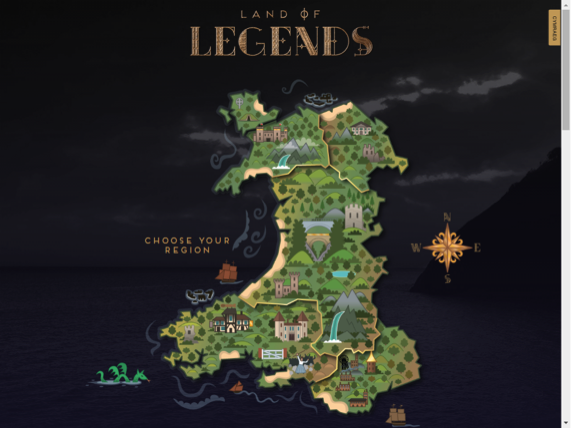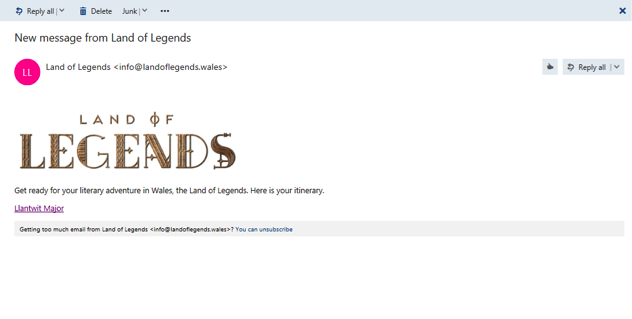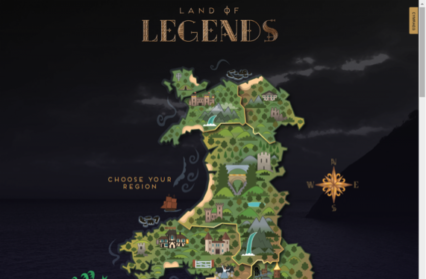Like it or not, there’s a website or an app for everything these days, especially when it comes to the tourism industry. So Literature Wales should be commended for their efforts to bring together the recent spatial turn in literary studies with the increasingly popular literary tourism industry in a new website, launched earlier this year. The excitingly-named Land of Legends is a literary tourism endeavour, part-funded by Visit Wales to encourage visitors to engage with Wales’ rich literary heritage. The project operates on two levels: firstly users search the website to identify places they wish to visit and find out about; secondly, users request that an itinerary for their visit is emailed directly to them for use when they make their trip.
 The colourful, bilingual, website is split into ten different categories and users are encouraged to ‘discover your legend’ by selecting an option from: Rebels; Sacred and Spiritual; Childhood; King Arthur; Boots and Bread; Living Language; Folklore and Tradition; Watery Worlds; Battles; and Ghosts. Alternatively, users can discover points of interest in a specific geographical location by clicking on the relevant section of an interactive map of Wales. Contributors have been drawn together from across the literary, academic and tourist sectors of Wales and the initial impact of the website is both dramatic and striking.
The colourful, bilingual, website is split into ten different categories and users are encouraged to ‘discover your legend’ by selecting an option from: Rebels; Sacred and Spiritual; Childhood; King Arthur; Boots and Bread; Living Language; Folklore and Tradition; Watery Worlds; Battles; and Ghosts. Alternatively, users can discover points of interest in a specific geographical location by clicking on the relevant section of an interactive map of Wales. Contributors have been drawn together from across the literary, academic and tourist sectors of Wales and the initial impact of the website is both dramatic and striking.
To really test it out, I decided to don my best tourist hat and try the website from the perspective of someone wanting to explore an area they’re not familiar with. I looked at the map of Wales and selected Llantwit Major from the colourful place markers, conscious that in spite of living only around forty miles from the area, it’s a place I know very little about when it comes to literary history. The area was marked as part of the Folklore and Tradition category, offering ‘weird and wonderful Welsh myths’, a promising start to my search. The page which opened next was encouraging; there were some beautiful images of Llantwit Major and a video about St Illtyd’s Church. The accompanying text paragraph informed me of the town’s blue plaque trail and explained the area’s connections to cult folklorist Marie Trevelyan. Marie Trevelyan’s name was highlighted in bold within the text and I was slightly surprised to discover that this highlighting was just for emphasis, rather than a link to any further information about her, but possibly this is a feature that Literature Wales intend to expand in the future. Nevertheless, the paragraph was interesting and informative and convinced me that there would be plenty to discover on a visit, so I added the area to my list and typed in my email address to be told that my itinerary had been sent to me.
So far, so good. Yet as I opened my emails and clicked on the message I’d just been sent by the Land of Legends website, I couldn’t help feeling a little disappointed with the content. The email which promised an itinerary contained only a link to Google Maps, offering no further information and no reminder of why I had selected Llantwit Major in the first place. In essence, I could have achieved the same result by typing ‘Llantwit Major’ into the Google search engine and selecting the ‘Maps’ tab. For tourists planning their visit in advance of a trip, the lack of additional information within the email seems like a major drawback, as well as a wasted opportunity to remind users of why they initially chose to visit a specific place. This lack of information could be particularly problematic if visitors were to choose multiple locations which they wished to visit, and then find themselves unable to recall why they had selected them. I tried the same experiment with a number of other locations and each time received the same very basic email with just a link to Google Maps.
There can be no doubt that the concept behind the Land of Legends website is a good one; a fun, interactive and informative website which guides potential visitors towards literary sites in Wales can only be a positive. The text is interesting and readable and, in some instances, accompanied by a fascinating video about the area. The quality of these entries is testament to the work done by the contributors to the site who have clearly put a considerable amount of time and thought into emphasising the literary connections within different locations.
In spite of these positives I couldn’t help feeling that there was a chasm between what the website seeks to offer and what the email actually delivers. At present, the email content sent to users once they have chosen a destination fails to live up to the bright, enthusiastic appearance of the main site. In reality, the website currently promises a little more than it seems technically equipped to provide.
A few relatively small adjustments would improve the user experience considerably and enable both parts of the project to live up to their full potential. Firstly, and arguably most importantly, it would be useful to add the text from the website to the email which is sent out to users once they have chosen a destination. Having this information directly available via an email stored on a smartphone (or similar device) would enable tourists to refresh their memory about why they wanted to visit a specific place and what features they should look out for. Secondly, the website itself might benefit from the inclusion of further practical information if it is to meet the expectations of the term ‘itinerary’. Details such as nearest train station, where to park, or the best times to visit are not available and the problem of expecting users to return to Google Maps and search for this information themselves is that, at times, it threatens to reduce the Land of Legends website to the role of a directory.
Finally, there are a few inconsistencies within different entries on the website, with the level of information available about different locations varying quite considerably. While all the entries include a detailed paragraph about the literary significance of a specific location, some also contain links to websites for the area, or further background information about the literary figures involved, while other entries are missing these features.
The idea of the Land of Legends website is exciting and innovative, guiding potential tourists and visitors towards a rich literary heritage which they can explore as part of their visit to an area. The website design is fresh and engaging, and I have no doubt that the ten legend categories, each represented by a colourful image, could also be a brilliant way to involve children in planning a trip. Yet while I don’t know what Literature Wales and Visit Wales have planned for the future of Land of Legends, it feels as if there is so much more which could be done with the foundation laid here. My hope is that the momentum and enthusiasm which has clearly built up as the Land of Legends website was created, will continue to grow and allow the site, and its accompanying email feature, to develop and expand in the future, doing full justice to the places it seeks to showcase.











